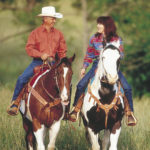The simplest version of Combined Driving seems to confuse even the most experienced competitors and organizers. The simple truth about them is that they are simple. Of course, the rules only tell you what the penalties are and what you’re supposed to do before you go wrong.
Organizing an ADT is all about scheduling! You have the entire number of competitors to get in and out of the ring many times. Using one ring, the most you could fit in a day is 35 competitors. That takes a lot of hustling and a fabulous ring steward. Anything can cause a delay. A first time organizer should limit the entry to 20.
As with all combined driving competitions, we start with Dressage. For ADT?s we have specific tests available to use in a small arena. These tests were written for an average indoor arena measuring 20m x 50 m. If an arena is longer, and still about 20m wide, it is better to use boards at one end to shorten and bring the ring into proportion. Your judge will have room to sit behind these. Also, the test will not drive correctly if the ring is out of proportion and the suggested times will not work for scheduling if the ring is too large.
You have a choice for what comes next. It’s better to run the marathon obstacles next. It is more exciting to run in traditional order because spectators and fellow com- petitors will better predict the outcome by the number of balls that drop than watching marathon obstacles that are primarily scored on time.
The two obstacles need to be constructed out of safe, easy to move materials. It is best to construct them so they can be knocked over and crushed without hurting an animal or flipping a carriage. The best obstacles used for ADT?s can be easily constructed with hand tools. Corrugated plastic sheets can be purchased in a variety of colors. These sheets can be cut with a razor knife and then screwed or duct-taped together or to a PVC pipe. In ADTs, the height requirement for a gate is still a concern. 1.30m is just a bit over four feet. Corrugated sheets come in 4 x 8?s. Cut the sheets into 32 inch sections, and you get the best yield for your money.
Another very successful obstacle is built from concrete tube forms. The 8, 10 and 12 inch nominal size tubes are the best. They also come in four-foot lengths. Put a bottom in, throw in a five pound weight, and you have another safe object to drive around.
All gates are best spaced at 3 meters. Also be sure to allow the same space off the arena walls. The start finish line should be at least 5 meters from any element in the obstacle. You may have a knockdown on as many of the elements as you like.
Depending on the time you have with your competitors, you could reflag and have them drive a totally different route to get the four obstacle scores. In the interest of time, having the competitors run through them twice with a one minute break between 3 & 4 has been very common. This saves a lot of time and the animals only need to come into the ring once for this phase.
Finish the day with cones. In an arena, 10 sets is more than enough. We are now beginning to use numbered sleeves on the cones to make set up faster and have more course space to drive between. If the arena is larger than 20 x 50, you could add sets accordingly. (Maybe 12 sets for a 30 x 60).
The less you have, the faster the schedule goes. Remember, we still have to measure for almost every round.
For both marathon obstacles and cones, it is strongly suggested that electronic timing be used. The scores are very small and close together. There have been many placings decided by hundredths of seconds in this format. A slow thumb on a stopwatch can really hurt a competitor.
Course maps are a must. The marathon obstacle and cones diagrams can easily fit on one sheet. There isn?t much time for the competitors to walk them to memorize them.
Arena Driving Trials are a successful way to bring more people to Combined Driving. Many competitors started in the Northeast at ADTs and have made it all the way to FEI level. Keeping these competitions running smoothly and safely will ensure this new competition keeps growing. And don’t forget, financial support for new ADTs is avail- able from the ADS Fund.?Since time is limited for walking the cones course and the obstacles, it is important to have diagrams on paper to give to competitors.?These elements are made from sheets of colored corrugated plastic attached to PVC pipe corners. Notice the knockdowns ? there is no limit on the number that can be used in an ADT.





